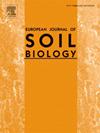Evaluating DNA extraction methods for eDNA metabarcoding of soil invertebrate diversity
IF 3.3
2区 农林科学
Q1 ECOLOGY
引用次数: 0
Abstract
Metabarcoding of environmental DNA (eDNA) has been increasingly used in assessing soil biodiversity, primarily for microorganisms but also for invertebrates. Currently, conventional morphological identification (CMI) for detecting microarthropods and earthworms involves extracting them via heat treatment or hand-sorting from soil blocks, and subsequent morphological identification. To compare the soil fauna community composition assessment methods, we compared CMI, DNA metabarcoding of heat-extracted invertebrates (comDNA), and DNA extracted directly from soil (eDNA). For eDNA, two commercially available QIAGEN DNA extraction kits were further compared: DNeasy Powerlyzer PowerSoil kit (eDNA_PS), based on 0.25 g of soil, and DNeasy PowerMax soil kit (eDNA_PM), based on 10 g of soil. PowerMax captured higher richness, while PowerSoil captured diversity comparable to that of comDNA. In eDNA and comDNA samples, arthropods dominated the community composition, followed by annelids. Both eDNA and comDNA methods captured several overlapping species,; however, each method also detected unique ASVs. Interestingly, comDNA captured a higher abundance of several ASVs that were not detected in eDNA. Regardless of the methods used, the location of the soil sampled showed a significant effect on soil fauna community structure. Several species detected or shared in DNA-based methods were also shared with CMI, and a few collembolan species detected by eDNA were also correlated with the abundance data from CMI. Further, the community composition of collembolans varied between the comDNA and two eDNA (eDNA_PS, eDNA_PM) methods; however, more than one-third of the species were detected across all three methods. Our findings show the complementarity of eDNA and comDNA and support the integration of DNA-based methods in future soil fauna biodiversity assessment programs.
土壤无脊椎动物多样性eDNA元条形码提取方法的评价
环境DNA元条形码(eDNA)已越来越多地用于评估土壤生物多样性,主要用于微生物,但也用于无脊椎动物。目前,用于检测微节肢动物和蚯蚓的传统形态鉴定(CMI)包括通过热处理或手工分选从土壤块中提取它们,然后进行形态鉴定。为了比较土壤动物群落组成的评价方法,我们比较了CMI、热提取无脊椎动物DNA元条形码(comDNA)和土壤直接提取DNA (eDNA)。对于eDNA,进一步比较了两种市售的QIAGEN DNA提取试剂盒:基于0.25 g土壤的DNeasy Powerlyzer PowerSoil kit (eDNA_PS)和基于10 g土壤的DNeasy PowerMax soil kit (eDNA_PM)。PowerMax的丰富度较高,而PowerSoil的多样性与comDNA相当。在eDNA和comDNA样品中,节肢动物的群落组成占主导地位,其次是环节动物。eDNA和comDNA方法都捕获了几个重叠的物种;然而,每种方法也检测到独特的asv。有趣的是,comDNA捕获了eDNA中未检测到的几种asv的丰度更高。无论采用何种方法,取样土壤的位置对土壤动物群落结构都有显著影响。基于dna的方法检测到或共享的一些物种也与CMI共享,并且eDNA检测到的一些collebolan物种也与CMI的丰度数据相关。此外,comDNA和eDNA_PS、eDNA_PM两种eDNA方法对collbolans的群落组成存在差异;然而,三种方法都能检测到超过三分之一的物种。我们的研究结果显示了eDNA和comDNA的互补性,并支持在未来的土壤动物生物多样性评估计划中整合基于dna的方法。
本文章由计算机程序翻译,如有差异,请以英文原文为准。
求助全文
约1分钟内获得全文
求助全文
来源期刊

European Journal of Soil Biology
环境科学-生态学
CiteScore
6.90
自引率
0.00%
发文量
51
审稿时长
27 days
期刊介绍:
The European Journal of Soil Biology covers all aspects of soil biology which deal with microbial and faunal ecology and activity in soils, as well as natural ecosystems or biomes connected to ecological interests: biodiversity, biological conservation, adaptation, impact of global changes on soil biodiversity and ecosystem functioning and effects and fate of pollutants as influenced by soil organisms. Different levels in ecosystem structure are taken into account: individuals, populations, communities and ecosystems themselves. At each level, different disciplinary approaches are welcomed: molecular biology, genetics, ecophysiology, ecology, biogeography and landscape ecology.
 求助内容:
求助内容: 应助结果提醒方式:
应助结果提醒方式:


